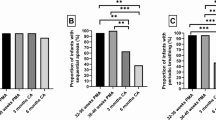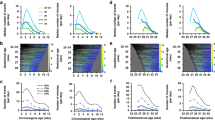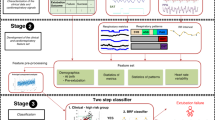Abstract
ABSTRACT: Twenty healthy preterm infants of less than 34 wk gestation were studied with continuous recordings, commencing within 8 h of birth, for up to 1 wk of age to determine the usual time course of the appearance of apnea and to classify apnea types. Airway occlusion studies were also performed on a regular basis to determine whether apneic spells were preceded or followed by a reduction in central respiratory drive. Apneic spells of greater than 15 s duration accompanied by hypoxia or bradycardia occurred in all infants before 24 h of age. The frequency of apneic spells was highest in the first 24 h after birth with a mean frequency of 0.9/h and gradually reduced thereafter, falling to 0.2/h by 5 d of age (p < 0.01). Apneic spells were more likely to be obstructive in the first 2 d of life than thereafter (p < 0.05). Central apnea was proportionately significantly less frequent during this time period. Reduced respiratory drive, as demonstrated by airway occlusion pressures, was associated with more frequent apnea and was evident at the first occlusion study, which frequently preceded the first significant apnea.
Similar content being viewed by others
Log in or create a free account to read this content
Gain free access to this article, as well as selected content from this journal and more on nature.com
or
Author information
Authors and Affiliations
Rights and permissions
About this article
Cite this article
Barrington, K., Finer, N. The Natural History of the Appearance of Apnea of Prematurity. Pediatr Res 29, 372–375 (1991). https://doi.org/10.1038/pr.1991.72500
Received:
Accepted:
Issue date:
DOI: https://doi.org/10.1038/pr.1991.72500
This article is cited by
-
Wide variation in caffeine discontinuation timing in premature infants
Journal of Perinatology (2020)
-
Clinically significant cardiopulmonary events and the effect of definition standardization on apnea of prematurity management
Journal of Perinatology (2017)
-
A pilot randomized trial of high-dose caffeine therapy in preterm infants
Pediatric Research (2015)
-
Essential childbirth and postnatal interventions for improved maternal and neonatal health
Reproductive Health (2014)
-
The effects of caffeine on heart rate variability in newborns with apnea of prematurity
Journal of Perinatology (2014)



